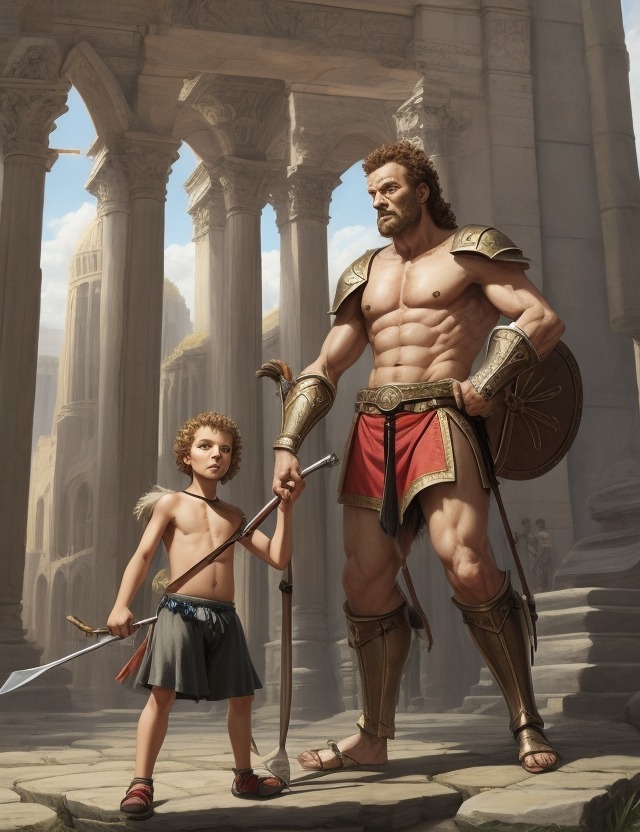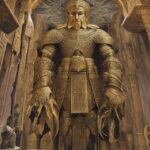In the face of seemingly insurmountable adversaries, history has gifted us with countless tales of underdogs who defy the odds and triumph against all expectations. Among these enduring legends, none is more celebrated than the biblical story of David and Goliath. However, beneath the surface of this ancient tale lies a profound message that transcends time—a powerful lesson on resilience, courage, and strategic thinking.
Now, let us delve into the pages of Bible insightful masterpiece, where intriguing revelations await, forever changing our perception of adversity and imbuing us with the tenacity to face our own Goliaths head-on.
Short Summary of the Story of David and Goliath
David and Goliath Story from the Bible
Summary of David and Goliath for Preschool. Once upon a time, in a land called Israel, there lived a young shepherd boy named David. David was small, with bright eyes and a curly mop of hair. He was kind, brave, and loved by everyone in his village.
In the neighboring land of Philistia, there was a great warrior named Goliath. Goliath was a giant, towering over everyone with his enormous size and strength. He wore a shiny bronze armor and a helmet that gleamed in the sun. Goliath was feared by all, for he had won countless battles and seemed invincible.
One day, the Philistines and Israelites were preparing for battle. The Philistines, led by Goliath, assembled on one side of the valley, while the Israelites gathered on the other side. King Saul, the ruler of Israel, was worried. He didn’t know how to defeat Goliath and his army, and his soldiers were scared to face the giant.
Meanwhile, David’s father, Yishai, sent him to deliver food to his three older brothers who were soldiers in the Israelite army. David eagerly set off, carrying a basket of fresh bread and cheese. When he reached the camp, he saw the soldiers trembling with fear.
Curious, David asked why they were so scared. His brothers explained that Goliath had challenged the Israelites to send a champion to face him in one-on-one combat. But no one was brave enough to accept the challenge. David couldn’t believe it.
Filled with courage, David went to King Saul and said, “Your majesty, I will fight Goliath!” The king was shocked. “But you are just a young boy, and Goliath is a mighty warrior!” he exclaimed. However, when he saw the determination in David’s eyes, he allowed him to try.
David refused the armor and weapons offered to him, as they were too big and heavy. Instead, he armed himself with five smooth stones from a nearby stream and his slingshot – a weapon he had used many times to protect his sheep from wild animals.
With a prayer to God for strength, David marched toward Goliath. The giant laughed at the sight of this small boy. “Am I a dog that you come at me with sticks?” Goliath jeered. But David was not afraid.
He fearlessly shouted back, “You come to me with swords and spears, but I come to you in the name of the Lord Almighty!” With a swift motion, David hurled a stone from his slingshot towards Goliath. The stone flew through the air, hitting the giant right between the eyes.
Goliath stumbled and fell with a thunderous crash. The Philistines watched in shock as their champion was defeated by a mere shepherd boy. The Israelites erupted in cheers and rushed forward to fight the Philistines, who were now terrified.
David’s bravery and trust in God had inspired his fellow soldiers. Together, they fought with great strength and unity, driving the Philistines away. Israel celebrated their victory, with David being hailed as a hero.
King Saul was amazed by David’s courage and skill. He even offered David a place in his army. However, David declined the offer, choosing to return to his peaceful life as a shepherd. He continued to play his harp, sing songs of praise to God, and compose beautiful psalms.
From that day forward, David’s name spread across the land as a symbol of hope and bravery. He became known as the shepherd boy who defeated Goliath. His story taught people that courage could come from the most unexpected places and that even the smallest individuals could achieve great things.
Generations later, people would tell the tale of David and Goliath as a reminder that faith, bravery, and believing in oneself can conquer any challenge. So, dear children, always remember that no matter how big the obstacles may seem, with determination and faith, you too can slay your own “Goliath” and become the hero of your own story.
David and Goliath: Key Themes
The book of David and Goliath is a famous biblical account found in the Old Testament. It tells the story of a young shepherd named David who defeats the giant warrior Goliath using unconventional means. This narrative carries several key themes:
1. Courage and Faith: One of the central themes of the story is the importance of courage and faith in the face of seemingly insurmountable challenges. David, as a young shepherd, represents an underdog who defies the odds and trusts in God’s strength. Despite being physically smaller and lacking experience in combat, David exhibits tremendous bravery and confidence in his abilities. His unwavering faith in God allows him to conquer his fears and stand up against Goliath, demonstrating that with determination and reliance on a higher power, anything is possible.
2. Power of Unconventional Methods: Another significant theme in the story is the power of unconventional methods and thinking outside the box. When David is offered conventional armor and weapons to face Goliath, he chooses to refuse them and instead uses his slingshot and stones to defeat the giant. This unconventional approach highlights the importance of utilizing one’s unique strengths and skills to overcome challenges. David’s choice to rely on his expertise as a shepherd, a seemingly insignificant occupation in the eyes of others, proves to be his advantage, emphasizing the value of individuality and innovation.
3. Triumph of the Weak Over the Strong: The story of David and Goliath also conveys a theme of how the weak can triumph over the strong. Goliath, being a mighty warrior and towering giant, represents the embodiment of strength and power. In contrast, David, a young shepherd, initially appears to be no match for his opponent. However, the tale takes an unexpected turn, as David’s agility, strategy, and trust in God enable him to defeat Goliath. This narrative serves as a reminder that physical strength and intimidating appearances do not always equate to victory. Instead, the story portrays how individuals who may be considered weaker or disadvantaged can achieve great feats through determination, intelligence, and the aid of a higher power.
David and Goliath: Characters
1. David:
David is the courageous and unassuming protagonist of the story. Despite being just a young shepherd boy, he possesses an unwavering faith in his abilities and an unyielding determination to face any challenge that comes his way. With his nimble frame and a shock of unruly dark curls, David’s wide grin and bright, shining eyes radiate optimism and fearlessness. His quick thinking and resourcefulness make him a formidable adversary, as he triumphantly stands up against the mighty Goliath with nothing but his trusty slingshot and a heart full of unwavering faith.
2. Goliath:
Goliath, a towering and imposing figure, is the fearsome antagonist of the story. Standing at over nine feet tall, with bulging muscles and a menacing scowl, he is the champion of the Philistine army. However, beneath his intimidating exterior lies a comically clumsy side. His incredible strength is rivaled only by his inability to coordinate his movements, hilarious trips, and exaggerated attempts at grace. This juxtaposition of his physical prowess and his lack of coordination adds a touch of unexpected humor to an otherwise daunting opponent. Ultimately, Goliath’s arrogance becomes his downfall, as David uses his wit and skill to bring the giant crashing to the ground before the crowd’s astonished eyes.
3. Samuel:
Samuel, an aging prophet in the story, serves as the spiritual guide and mentor to David. With a long gray beard and piercing blue eyes, Samuel possesses an aura of wisdom and authority. He is known for his stentorian voice and powerful presence, yet his gentle and soft-spoken nature reveals a kind heart. Samuel recognizes David’s potential even before he sees him, a mere shepherd, as the one to defeat Goliath. With his sage advice and unwavering belief in the divine power guiding their actions, Samuel inspires David to embrace his destiny and face the challenges that lie ahead.
4. Eliab:
Eliab is David’s older brother, who initially dismisses his younger sibling’s audacious dreams of combating Goliath. With a tall stature and muscular build, he personifies strength and authority within their family. However, Eliab’s imposing demeanor hides a touch of jealousy over David’s potential. Through their entertaining banter and sibling rivalry, Eliab’s character adds a relatable element of familial dynamics and human emotions to the story. Despite their differences, their bond as brothers prevails and serves as a reminder that unity and love can overcome any obstacle.
5. Michal:
Michal, the daughter of King Saul, adds a romantic subplot to the story. With her flowing auburn hair and sparkling green eyes, she is renowned for her beauty and grace. Her fiery spirit and independent nature make her stand out among the other characters. Michal is captivated by David’s bravery and unwavering faith, falling deeply in love with him. She supports him in secret, adds a touch of tenderness to the story, and ultimately becomes David’s wife, their love serving as a symbol of companionship and support during troubled times.
6. King Saul:
King Saul, the ruler of Israel at the time, is portrayed as a conflicted and insecure king. With greying hair and a slight hunch to his posture, Saul wears the weight of his crown on his weary shoulders. Beneath his regal façade, he struggles with self-doubt and a fear of failure. Saul’s character adds depth to the narrative as he grapples with his inability to face Goliath and initially underestimates David’s capabilities. His internal journey explores the hurdles one must overcome to find true strength and resilience, as he learns valuable lessons from the humble shepherd boy.
David and Goliath: Symbols
1) The stone: One of the most significant symbols in the story of David and Goliath is the stone that David uses to defeat Goliath. The stone represents David’s unwavering faith in God and his trust in his own abilities. It symbolizes the power of the underdog and the idea that even the smallest and most unexpected person can overcome great challenges. The stone also serves as a metaphor for David’s determination and resourcefulness in finding a simple solution to defeat a seemingly unbeatable enemy.
2) Armor: Another important symbol in the story is Goliath’s armor. Goliath is described as a giant warrior clad in heavy armor, representing his superior strength and military prowess. The armor symbolizes the reliance on physical strength, weapons, and conventional tactics that were typical in ancient warfare. In contrast, David chooses not to wear any armor and instead relies on his faith and agility. This symbolizes David’s rejection of conventional methods and his willingness to trust in God’s guidance, highlighting the power of spiritual strength over physical might.
3) Sword: The sword is a symbol of power, authority, and violence in the story. Goliath, as a renowned warrior, wields his massive sword as a representation of his dominance and ability to intimidate his enemies. David, on the other hand, refuses to use a sword and instead opts for his sling and stone. This symbolizes David’s rejection of violence and his reliance on his faith and individual skills. By defeating Goliath without a sword, David demonstrates that there are different ways to overcome obstacles and achieve victory that don’t necessarily involve the use of force or violence.
David and Goliath Verses in Bible
The story of David and Goliath is found in 1 Samuel 17. Here are some quotes from the story:
- “You come to me with a sword, with a spear, and with a javelin. But I come to you in the name of the Lord of hosts, the God of the armies of Israel, whom you have defied.” (1 Samuel 17:45)
- “Then David put his hand in his bag and took out a stone; and he slung it and struck the Philistine in his forehead, so that the stone sank into his forehead, and he fell on his face to the earth.” (1 Samuel 17:49)
David and Goliath: Culture Impact
David and Goliath, penned by renowned author Malcolm Gladwell, is a monumental literary work that made a profound cultural impact upon its publication. Drawing inspiration from the biblical tale of the underdog triumphing against all odds, this thought-provoking book weaves historical data, witty anecdotes, and remarkable achievements to present a fresh perspective on power dynamics and the concept of advantage.
With its release, David and Goliath sparked lively discussions and debates across various intellectual circles, challenging established notions of conventional strength and perceived weaknesses. Gladwell deftly delves into captivating stories of individuals and communities who defied expectations and embraced their disadvantages to achieve remarkable success. By intertwining historical events and contemporary examples, the book opens the reader’s eyes to the untapped power that can lie within adversity.
One of the most significant cultural impacts of David and Goliath lies in its ability to offer hope and inspiration. Gladwell’s engaging storytelling takes readers on a captivating journey, showcasing how ordinary people, armed with unconventional strategies and unwavering determination, can overcome seemingly insurmountable challenges. This empowering message resonated with audiences from all walks of life, revitalizing their belief that even the mighty can be toppled by those who refuse to succumb to fear or despair.
Furthermore, the book invites readers to reevaluate their perceptions of success and failure. Through historical data and fascinating case studies, Gladwell challenges the widely accepted notion that being at a disadvantage is a guaranteed path to defeat. He demonstrates that adversity can push individuals to develop resilience, creativity, and alternative approaches that can ultimately outwit and outmaneuver their opponents. Consequently, the book has sparked a cultural shift where individuals and organizations are encouraged to embrace their differences and view them as catalysts for personal and collective growth.
David and Goliath also left an indelible mark on popular culture, with references and allusions to the book becoming a part of everyday conversations. The story of the underdog overcoming tremendous odds has become a metaphor for courage, determination, and unconventional thinking. Whether it’s in the world of sports, business, or any other domain, the David and Goliath tale continues to serve as a reminder that success is not solely reserved for those with apparent advantages, but rather for those with audacity and the willingness to challenge the status quo.
In conclusion, David and Goliath revolutionized our understanding of power dynamics, inspiring individuals to rethink the constructs of strength and advantage. Its cultural impact has been evident in the way society now views adversity, success, and the limitless potential individuals possess when faced with challenges. Gladwell’s masterful combination of historical analysis, humor, and achievements has undoubtedly shaped our collective mindset, encouraging us to embrace our differences and rewrite the narrative of our own lives.
David and Goliath Questions
- What is the main theme or message of David and Goliath?
A: The main theme of the book revolves around the idea that disadvantages can sometimes be turned into advantages, and that strength can come in unexpected forms. - What Book of the Bible is David and Goliath In?
The story of David and Goliath is found in 1 Samuel 17. - Is David and Goliath suitable for all ages?
While David and Goliath can be read by individuals of different age groups, it may be more suitable for young adults and above due to its complex ideas and theories. - What Does David and Goliath Symbolize?
The story of David and Goliath symbolizes the power of faith and courage. David, a young shepherd boy, defeated the giant Goliath with a single stone and a slingshot. The story teaches us that with faith in God, we can overcome seemingly impossible obstacles. It also symbolizes the importance of humility and the dangers of pride. - Is David and Goliath a Parable?
David and Goliath is not a parable, but a historical account of an event that took place in ancient Israel. The story is found in 1 Samuel 17 and tells of how David, a young shepherd boy, defeated the giant Goliath with a single stone and a slingshot.










